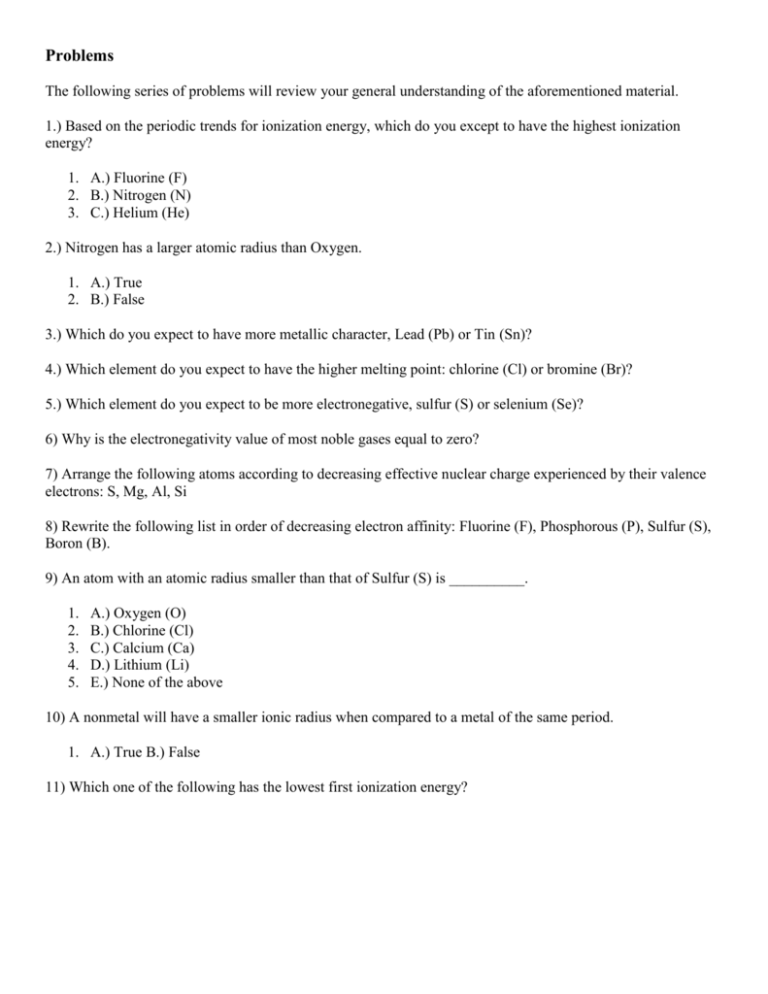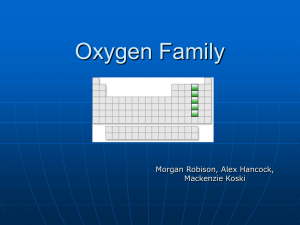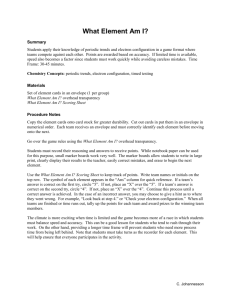Problems - TeacherWeb
advertisement

Problems The following series of problems will review your general understanding of the aforementioned material. 1.) Based on the periodic trends for ionization energy, which do you except to have the highest ionization energy? 1. A.) Fluorine (F) 2. B.) Nitrogen (N) 3. C.) Helium (He) 2.) Nitrogen has a larger atomic radius than Oxygen. 1. A.) True 2. B.) False 3.) Which do you expect to have more metallic character, Lead (Pb) or Tin (Sn)? 4.) Which element do you expect to have the higher melting point: chlorine (Cl) or bromine (Br)? 5.) Which element do you expect to be more electronegative, sulfur (S) or selenium (Se)? 6) Why is the electronegativity value of most noble gases equal to zero? 7) Arrange the following atoms according to decreasing effective nuclear charge experienced by their valence electrons: S, Mg, Al, Si 8) Rewrite the following list in order of decreasing electron affinity: Fluorine (F), Phosphorous (P), Sulfur (S), Boron (B). 9) An atom with an atomic radius smaller than that of Sulfur (S) is __________. 1. 2. 3. 4. 5. A.) Oxygen (O) B.) Chlorine (Cl) C.) Calcium (Ca) D.) Lithium (Li) E.) None of the above 10) A nonmetal will have a smaller ionic radius when compared to a metal of the same period. 1. A.) True B.) False 11) Which one of the following has the lowest first ionization energy? 1. 2. 3. 4. A. Element A B. Element B C. Element C D. Element D Solutions 1. Answer: C.) Helium (He) Explanation: Helium (He) has the highest ionization energy because, like other noble gases, Helium's valence shell is full. Because of this, Helium is stable and does not readily lose or gain electrons. 2. Answer: A.) True Explanation: According to periodic trends, atomic radius increases from right to left on the periodic table. Therefore, we would expect Nitrogen to be larger than Oxygen. 3. Answer: Lead (Pb) Explanation: Lead and Tin share the same column. According to periodic trends, metallic character increases as you go down a column. Lead is underneath Tin therefore we would expect Lead to possess more metallic character. 4. Answer: Bromine (Br) Explanation: According to periodic trends, in non-metals, melting point increases down a column. Since chlorine and bromine share the same column, we would expect bromine to possess the higher melting point. 5. Answer: Sulfur (S) Explanation: Note that sulfur and selenium share the same column. Periodic trends tell us that electronegativity increases up a column. This indicates that sulfur is more electronegative than selenium. 6. Answer: Most noble gases have full valence shells. Explanation: Because of their full valence electron shell, the noble gases are extremely stable and do not readily lose or gain electrons. 7. Answer: S > Si > Al > Mg. Explanation: The electrons above a closed shell are shielded by the closed shell. S has 6 electrons above a closed shell, so each one feels the pull of 6 prontons in the nucleus. 8. Answer: Fluorine (F)>Sulfur (S)>Phosphorous (P)>Boron (B) Explanation: According to periodic trends, the electron affinity generally increases from left to right and from bottom to top. 9. Answer: C.) Oxygen (O) Explanation: Periodic trends indicate that atomic radius increases up a group and from left to right across a period. Therefore, oxygen is expect to have a smaller atomic radius than of sulfur. 10. Answer: B.) False Explanation: The reasoning behind this lies in understanding that a metal usually loses an electron in becoming an ion while a non-metal gains an electron. This results in a smaller ionic radius for the metal ion and a larger ionic radius for the non-metal ion. 11. Element D Explanation: Element A, B and D have the same number of elentrons in the inner shell, but element D has the least number of eletrons in the outer shell which requires the lowest ionization energy.




